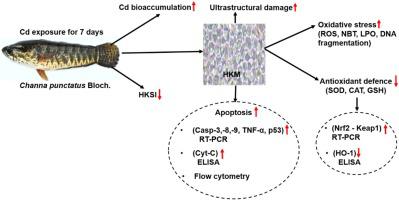Aquatic Toxicology ( IF 4.5 ) Pub Date : 2020-12-31 , DOI: 10.1016/j.aquatox.2020.105739 Chohelee Choudhury , Ritwik Mazumder , Rajeev Kumar , Bishal Dhar , Mahuya Sengupta

|
Cadmium (Cd) with no known functional role in any life-form has myriad of harmful effects. The present study was designed to elucidate the mechanism of Cd-induced oxystress generation and its impact on antioxidant and apoptosis signaling pathways in head kidney macrophage (HKM) of Channa punctatus Bloch. Fish were sampled and acclimatized with one group treated with cadmium chloride (CdCl2) (1.96 mg/L) and another as untreated control group, both kept under observation for 7 days. Exposure to Cd caused ultrastructural changes along with reduced head kidney somatic index (HKSI). Significantly increased levels of reactive oxygen species (ROS), respiratory burst activity, lipid peroxidation, DNA fragmentation and superoxide dismutase were found in the HKM from the treated group as compared to control. In contrast, antioxidant enzymes like catalase and reduced glutathione activity decreased in the Cd exposed group. The suppressed antioxidant activity was further confirmed and corroborated from the altered expression of Kelch-like ECH-associated protein 1 (Keap1) and nuclear factor erythroid 2-related factor 2 (Nrf2) genes, the major player of antioxidant pathway. Cd induced alteration in Nrf2-Keap1 signaling pathway was also validated by the diminished levels of Nrf2 dependent expression of protein like heme oxygenase-1 (HO-1). The flow cytometry analysis supported the event of apoptosis in Cd exposed group as compared to control, which was further confirmed by the upregulated expression of caspase-3, caspase-8, caspase-9, TNF-α and p53 genes from the real-time gene expression study. In addition, altered protein level of cytochrome C validates the incidence of apoptosis. Altogether, our results demonstrate that exposure to Cd caused oxidative stress in HKM of Channa punctatus Bloch. by compromising the antioxidant enzyme activities via the down regulation of expression of genes related to antioxidant signaling pathway besides encouraging apoptosis via both mitochondrial and death receptor pathway.
中文翻译:

镉诱导的氧应激改变Nrf2-Keap1信号传导并触发鱼的头部肾脏巨噬细胞凋亡
在任何生命形式中均不具有已知功能的镉(Cd)具有多种有害作用。本研究旨在阐明Cd诱导氧应激产生的机理及其对Chuncun punctatus Bloch头部肾脏巨噬细胞(HKM)抗氧化和凋亡信号通路的影响。对一组鱼类进行采样并使其适应环境,其中一组接受氯化镉(CdCl 2)(1.96 mg / L)和另一个未治疗的对照组,均保持观察7天。镉暴露会导致超微结构的改变,同时降低头肾的体细胞指数(HKSI)。与对照组相比,在治疗组的HKM中发现活性氧(ROS),呼吸爆发活性,脂质过氧化,DNA片段化和超氧化物歧化酶水平显着增加。相反,在镉暴露组中,过氧化氢酶等抗氧化酶和谷胱甘肽活性降低。抑制的抗氧化活性得到进一步证实,并通过抗氧化途径的主要参与者,Kelch样ECH相关蛋白1(Keap1)和核因子红系2相关因子2(Nrf2)基因的表达改变得到了证实。镉诱导的Nrf2-Keap1信号传导途径的改变也通过像血红素加氧酶-1(HO-1)的Nrf2依赖性蛋白表达水平的降低来验证。与对照组相比,流式细胞仪分析支持了Cd暴露组的细胞凋亡事件,这进一步被caspase-3,caspase-8,caspase-9,TNF-α和p53基因的实时表达上调进一步证实基因表达研究。此外,细胞色素C蛋白质水平的改变证实了细胞凋亡的发生。总之,我们的结果表明,暴露于Cd会导致HKM中的氧化应激。实时基因表达研究显示,caspase-3,caspase-8,caspase-9,TNF-α和p53基因的表达上调进一步证实了这一点。此外,细胞色素C蛋白质水平的改变证实了细胞凋亡的发生。总之,我们的结果表明,暴露于Cd会导致HKM中的氧化应激。实时基因表达研究中caspase-3,caspase-8,caspase-9,TNF-α和p53基因的表达上调进一步证实了这一点。此外,细胞色素C蛋白质水平的改变证实了细胞凋亡的发生。总之,我们的结果表明,暴露于Cd会导致HKM中的氧化应激。Channa punctatus Bloch。除了通过线粒体和死亡受体途径促进细胞凋亡外,还通过下调与抗氧化剂信号通路相关的基因的表达来损害抗氧化剂酶的活性。



























 京公网安备 11010802027423号
京公网安备 11010802027423号